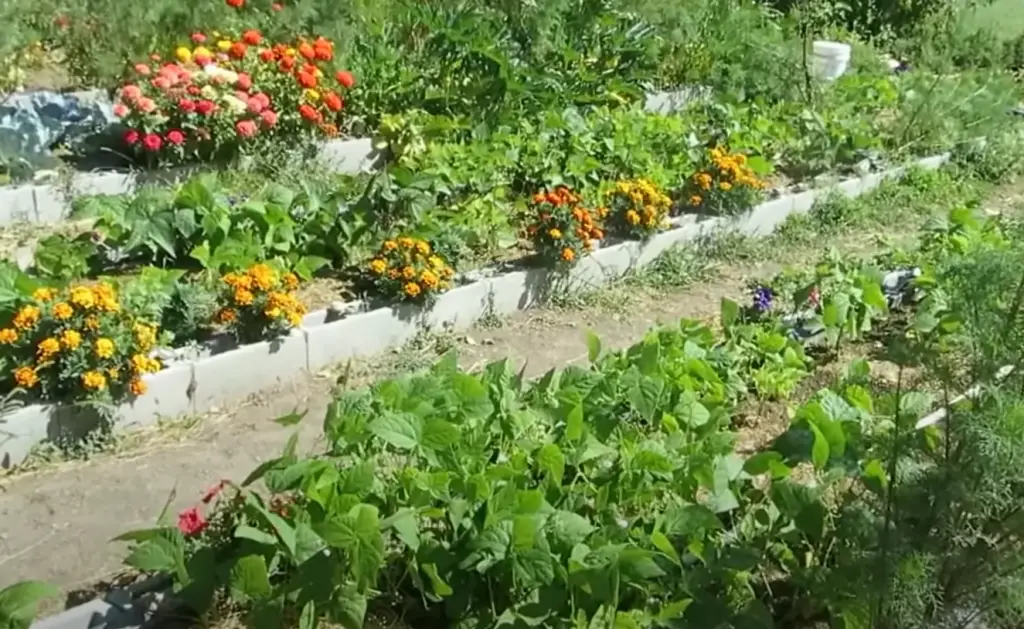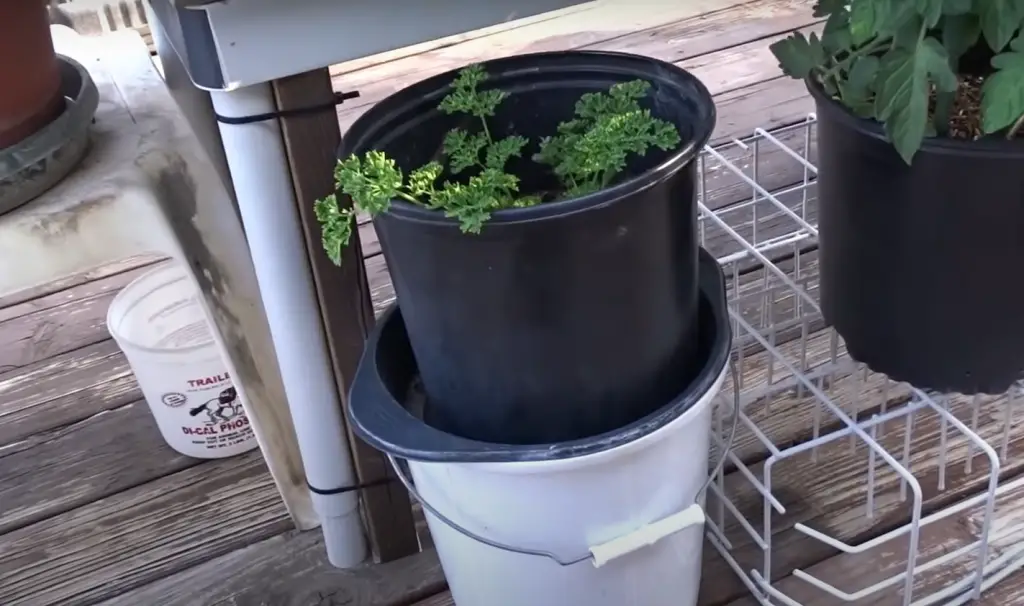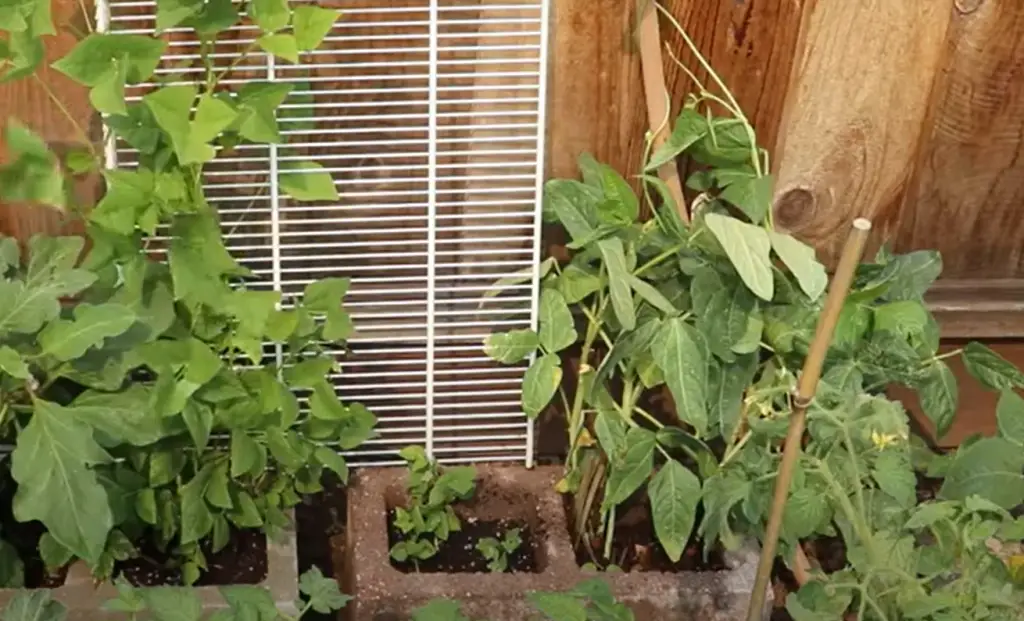Have you ever wanted to experiment with plants and gardening, but were limited in your options? Cinder block gardens are the answer! Their versatility provides a great opportunity for anyone to explore creative gardening ideas. Whether you’re looking to bring life and color to a balcony or spruce up your outdoor living space, many plants can thrive in cinder blocks. The possibilities are endless, so read on to find out which plants flourish in cinder block gardens.
Getting Started with Plants in Cinder Blocks
Now that you’ve got the basics down for building a cinder block planter, it’s time to get started with planting. Here are some tips for success:
- Choose Your Plants Wisely – Not all plants grow well in cinder blocks. Consider the size and shape of the cinder block and choose smaller-rooted plants like herbs or succulents that will have plenty of room to grow without overcrowding their space.
- Prep the Soil – Cinder blocks provide great drainage, but it’s important to fill them with soil that has been prepped for your specific plant type and location. If your planter is outdoors, add an extra layer of compost or fertilizer on top before you plant.
- Watering – When watering your plants, it’s important to remember that cinder blocks are porous and absorb water quickly. This means that water can evaporate quickly from the planter — be sure to check the soil regularly or invest in a moisture meter to ensure your plants are getting enough hydration.
- Fertilize Regularly – Cinder block planters may not provide the same nutrient-rich soil as traditional garden beds, so it’s important to fertilize regularly in order to give your plants the nutrients they need for healthy growth and blooming.
- Maintain Proper Sunlight Exposure – Many plants prefer some shade during certain times of day while other varieties thrive in full sunlight. Make sure to research the specific needs of your plants and adjust their location as necessary.
- Pruning and Maintenance – As with any garden, regular maintenance is key to keeping your cinder block planter healthy and thriving. Periodically prune away dead or overgrown foliage and trim back branches that have outgrown their space. With a little bit of effort, you can keep your cinder block planter looking great for years to come [1]!
18 Best Cinder Block Plants
Strawberries
Strawberries are a great option when it comes to cinder block plants.

They’re easy to grow and will produce fruit in as little as three months.
You’ll also want to provide them with plenty of water and fertilizer throughout the growing season.Tomatoes
Tomatoes are another popular option for cinder block planters. Tomatoes are vigorous growers, so you won’t have to wait long before you see results. Make sure you choose an indeterminate variety of tomatoes that will keep producing fruit all summer long, rather than one that will only bloom once. Position your cinder blocks in an area that gets direct sunlight for at least six hours each day and water them regularly.
Peppers
Peppers are a great choice for cinder block planters, as they’re easy to maintain and can produce bountiful harvests. Make sure you choose a pepper variety that’s suitable for the size of your planter – smaller varieties work best with smaller containers like cinder blocks. Peppers need plenty of sun, so make sure you position your planter in an area where it will get at least six hours of direct sunlight each day. Provide them with regular watering and fertilizer throughout the season for best results.
Eggplants
Eggplants are a great choice for cinder block planters, as they’re easy to grow and require minimal maintenance. Choose an eggplant variety that’s suitable for the size of your container – smaller varieties work best with smaller containers like cinder blocks. Eggplants need plenty of sunlight, so make sure you position your planter in an area where it will get at least six hours of direct sunlight each day. Provide them with regular watering and fertilizer throughout the season for best results.
Cucumbers
Cucumbers are also a great option when it comes to cinder block planters. Cucumbers love heat, so make sure you position your cinder blocks where they’ll get direct sunlight for at least 6 hours each day.

Cucumbers need regular water so make sure you keep an eye on them throughout the growing season and provide additional watering when needed.
Squash
Squash is another great option when it comes to cinder block planters. Squash loves plenty of sun, so make sure you position your cinder blocks in a spot where they’ll get direct sunlight for at least six hours each day. You’ll also want to provide them with plenty of water and fertilizer throughout the season for best results.
Basil
Basil is a great herb to grow in cinder block planters, as it’s easy to maintain and can produce large harvests. Make sure you choose a variety of basil that’s suitable for the size of your container – smaller varieties work best with smaller containers like cinder blocks. Position your planter in an area that gets direct sunlight for at least six hours each day and water it regularly.
Spinach
Spinach is another great choice for cinder block planters, as it’s easy to grow and requires minimal maintenance. Spinach needs plenty of suns, so make sure you position your planter in an area where it will get at least six hours of direct sunlight each day. Provide them with regular watering and fertilizer throughout the season for the best results.
Kale
Kale is also a popular choice for cinder block planters. Kale loves plenty of sun, so make sure you position your cinder blocks in an area where they’ll get direct sunlight for at least six hours each day. You’ll also want to provide them with plenty of water and fertilizer throughout the season for best results.
Carrots
Carrots are another great option when it comes to cinder block planters. Choose a variety of carrots that’s suitable for the size of your container – smaller varieties work best with smaller containers like cinder blocks. Position your planter in an area that gets direct sunlight for at least six hours each day and water it regularly. Carrots need consistently moist soil but don’t overwater them. Provide them with additional fertilizer throughout the season for best results.
Herbs
Herbs are also a great choice when it comes to cinder block planters. Choose an herb variety that’s suitable for the size of your container – smaller varieties work best with smaller containers like cinder blocks.

Position your planter in an area that gets direct sunlight for at least six hours each day and water it regularly. Herbs need plenty of sun and moisture, so make sure you provide them with regular watering and fertilizer throughout the season for the best results.
Carrots
Carrots are a great option for cinder block planters. Carrots love plenty of sun, so make sure you position your cinder blocks in an area where they’ll get direct sunlight for at least six hours each day. Provide them with regular watering and fertilizer throughout the season for best results. Carrots need consistently moist soil but don’t overwater them.
Lettuce
Lettuce is also a great choice for cinder block planters. Choose lettuce varieties that are suitable for the size of your container – smaller varieties work best with smaller containers like cinder blocks.
Lettuce needs plenty of sun and moisture, so make sure you provide them with regular watering throughout the season for best results.Petunias
Petunias are great flowers to grow in cinder block planters. Choose petunia varieties that are suitable for the size of your container – smaller varieties work best with smaller containers like cinder blocks. Position your planter in an area that gets direct sunlight for at least six hours each day and water it regularly.
Radishes
Radishes are another great option for cinder block planters. Choose a variety of radishes that’s suitable for the size of your container – smaller varieties work best with smaller containers like cinder blocks. Position your planter in an area that gets direct sunlight for at least six hours each day and water it regularly.
Sunflowers
Sunflowers are also a great choice for cinder block planters. Choose a variety of sunflowers that’s suitable for the size of your container – smaller varieties work best with smaller containers like cinder blocks.
Marigolds
Marigolds are another great choice for cinder block planters. Choose a variety of marigolds that’s suitable for the size of your container – smaller varieties work best with smaller containers like cinder blocks.
Garlic
Garlic is also a great option for cinder block planters. Garlic needs plenty of sun and moisture, so make sure you position your planter in an area that gets direct sunlight for at least six hours each day and provide it with regular watering throughout the season. Provide them with additional fertilizer throughout the season for best results.
What Plants Don’t Grow Well in Cinder Block Holes?
Certain plants may not grow well in cinder block holes, including those that require more soil depth than what is available within the cavity. These types of plants include shrubs and trees with larger root systems.

Some vegetables don’t do well either, since their roots need a lot of space to spread out and access nutrients from the soil. If you want to grow these types of plants in a cinder block hole, it’s best to use raised beds or containers placed on top of the blocks. Additionally, some drought-tolerant succulents may not survive in a cinder block hole because they prefer dry conditions. It can be difficult to keep cinder block holes consistently moist without constant watering which could lead to root rot. When in doubt, it’s always best to research the requirements of a particular plant before planting it in a cinder block hole.
Cinder block holes may also require more maintenance than other types of planters because they are prone to drying out quickly due to their porous nature. This means that you will likely need to water them more frequently and provide soil amendments as needed. Additionally, the plants growing in them should be monitored for signs of disease or pests since these can spread quickly through the cavities. Finally, if exposed to extreme temperatures (either hot or cold) cinder blocks could crack and cause damage to any plants inside them.
Are Cinder Blocks Safe for Vegetable Gardens?
Cinder blocks are an affordable and popular choice for building vegetable gardens. However, there are a few considerations that should be taken into account before using this material.
When it comes to safety, the primary concern with cinder blocks is their potential to leach metals or other minerals into the soil. As concrete products contain cement – which is made by combining limestone and clay – there may be trace levels of certain minerals present in the concrete mixture, including lead and chromium. While these elements occur naturally in small amounts, they can accumulate over time if too much of them enters the soil. Therefore, it is best to avoid using cinder blocks in areas where food-producing plants will be grown.
In addition, cinder blocks are porous and can absorb moisture. If they become saturated with water, they may start to crack or crumble over time, leading to instability in the garden bed walls.
Finally, cinder blocks are heavy and can be difficult to move around once installed. Therefore, it is best to plan when deciding on where you want your vegetable garden and stick to that location.
How to Plant in Cinder Blocks?
Cinder blocks are often used to create planters for an outdoor garden or as a part of a larger landscaping project. Planting in cinder blocks is not always easy, but with the right preparation, it can be done successfully. Follow these steps to learn how to plant in cinder blocks:
- Prepare the soil: Before you begin planting in the cinder block, you must first prepare the soil. Remove any rocks and weeds from the area and add nutrient-rich compost or fertilizer if necessary. Work it into the soil with a shovel until it’s mixed evenly throughout.
- Place the block: Carefully place your cinder block in its desired location and make sure it’s level. If you’re creating a planter, fill the cavity with soil until it’s full and slightly mounded above the top.
- Plant your plants: Depending on what type of plants you’re planting in the cinder block, choose ones that are suited to growing in containers and will do well in partial sunlight. Make sure to leave enough space between each plant for them to grow without overcrowding one another.
- Water regularly: Be sure to keep your plants watered, especially during periods of drought or intense heat. A drip irrigation system is ideal for this purpose as it helps ensure that your plants receive the right amount of water each day without having to manually water them yourself.
- Protect from extreme temperatures: If you live in an area that experiences extremely hot or cold temperatures, make sure to protect your plants from the elements by adding a layer of mulch around them. This will help insulate the soil and keep it at a more consistent temperature.

By following these steps, you’ll be able to easily plant in cinder blocks and create beautiful planters for your outdoor garden or landscaping project. With regular watering and maintenance, your plants should do well in their new home [2].
FAQ
Can plants grow in cinder?
No, cinder is too hard and does not have the necessary nutrients required for plant growth. In addition, it is often unstable and can shift which would affect the root system. If you’re looking to use a substrate for growing plants, try soil or compost mix. Additionally, there are many other options available that are specifically designed for plant growth like hydroponic systems or aeroponics. Whatever substrate you choose, make sure it has good drainage and enough nutrients to support your plants’ growth.
How do you use cinder blocks as planters?
Using cinder blocks as planters is a great way to add unique style and texture to your garden. It’s also an affordable option compared to buying a pre-made planter. To use cinder blocks as planters, start by selecting the size of the blocks you need. Make sure they are at least 8 inches thick or more for adequate strength and stability. Place them in the desired configuration on a level surface, such as soil or concrete. Fill the cores of each block with lightweight material like gravel or foam peanuts for drainage. Finally, add potting soil and plants to create your own personalized planter!
What are some alternatives to a cinder?
There are many alternatives available for those looking to avoid using cinders, such as gravel, sand, mulch, or even shredded rubber. Each of these alternatives has its own benefits and drawbacks depending on the application. Gravel is a great option for drainage while sand helps to retain moisture and prevents soil erosion. Mulch is a good choice for improving water retention in the soil and also provides additional nutrients for plants. Finally, shredded rubber acts as both an effective weed barrier and insulation material. Ultimately, the best alternative depends on your individual needs and preferences!
Can cinder be used as an outdoor flooring material?
Yes, cinder can be used as an outdoor flooring material in certain applications. It’s important to note that because it’s not a manufactured product like tile or stone, it doesn’t offer the same level of durability or protection. However, cinder can provide a unique look and texture to any outdoor space if sealed properly. Additionally, it’s an affordable solution compared to many of its alternatives. Before applying cinder as your flooring material, make sure you consult with a professional for advice on installation and care instructions!
Does cinder block absorb water?
Yes, cinder blocks do absorb water. This is why it’s important to seal them before using them in outdoor applications like patios or planters. Sealing helps to protect the blocks from moisture damage caused by rain or irrigation systems.

It also prevents algae and moss growth which can occur when porous materials are exposed to moisture. To properly seal a cinder block, use either a concrete sealer or waterproofing paint to cover the entire surface. Make sure it’s fully dry before using the blocks in any application!
Can I paint cinder?
Yes, you can paint cinder blocks for decorative purposes and to protect them from weather damage. Before painting, make sure to clean the blocks with a hose or power washer. Then apply an appropriate primer and finish coat of outdoor paint for best results. Keep in mind that if your blocks are exposed to water regularly, you will need to re-apply the paint every few years as it will eventually start to peel and chip. Additionally, be sure to read and follow all safety instructions on the paint and primer labels. Painting your cinder blocks can be a fun way to customize your outdoor space!
Useful Video: How To Grow Vegetable Garden in Cinder Blocks-Concrete Bricks Planter Raised Bed Container Gardening
Conclusion
Plants can grow well in cinder blocks if they are properly cared for. When selecting cinder blocks and other containers for plants, it is important to consider the size, shape, and material of the container to ensure that the plant has adequate drainage and air circulation. Cinder blocks may be a great choice for gardeners looking for a long-lasting, lightweight container option with minimal maintenance requirements. With proper care and regular watering, plants can thrive in cinder blocks!
References:
- https://balconyboss.com/garden/plants-and-planters/best-cinder-block-plants/
- https://backyardgardengeek.com/growing-plants-in-cinder-block-holes/










Leave a Reply
View Comments